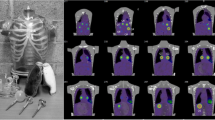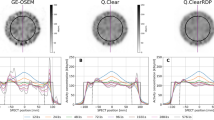Abstract
Purpose
In targeted radionuclide therapy (TRT), a prior knowledge of the absorbed dose biodistribution is essential for pre-therapy treatment planning. Previously, we showed that non-rigid organ-by-organ registration in sequential quantitative SPECT images improved dose estimation. This study aims to investigate if sequential CT can further improve TRT dosimetric accuracy.
Methods
We simulated SPECT/CT acquisitions at 1, 12, 24, 72 and 144 h In-111 Zevalin post-injection using an analytical MEGP projector, modeling attenuation, scatter and collimator-detector response. We later recruited a patient injected with 222 MBq In-111 DTPAOC imaged at 3 SPECT/CT sessions for clinical evaluations. Four registration schemes were evaluated: whole-body-based registration performed on sequential (1) SPECT (WB-SPECT) or (2) CT (WB-CT) images; organ-based registration applied on organs individually segmented from sequential (3) SPECT (O-SPECT) or (4) CT (O-CT) images. Voxel-by-voxel integration was performed followed by Y-90 voxel-S-kernel convolution. Organ-absorbed doses, iso-dose curves, dose–volume histograms (DVHs) were generated for targeted organs for analysis.
Results:
In simulation study, organ-absorbed dose errors were (− 8.66 ± 2.83)%, (− 2.51 ± 3.69)%, (− 9.23 ± 3.28)%, (− 7.17 ± 2.53)% for liver, (− 14.81 ± 4.91)%, (− 3.60 ± 4.37)%, (− 18.13 ± 4.44)%, (− 11.34 ± 4.22)% for spleen, for O-SPECT, O-CT, WB-SPECT and WB-CT registrations, respectively. For all organs, O-CT showed superior results. Results of iso-dose contour, DVHs were in accordance with the organ-absorbed doses. In clinical studies, the results were also consistent which showed O-CT method deviated the most from the result with no registration.
Conclusions:
We conclude that if both sequential SPECT/CT scans are available, CT organ-based registration method can more effectively improve the 3D dose estimation. Sequential low-dose CT scans might be considered to be included in the standard TRT protocol.







Similar content being viewed by others
References
Kramer-Marek G, Capala J. The role of nuclear medicine in modern therapy of cancer. Tumor Biol. 2012;33(3):629 – 40.
Loke KS, Padhy AK, Ng DC, Goh AS, Divgi C. Dosimetric considerations in radioimmunotherapy and systemic radionuclide therapies: a review. World J Nucl Med. 2011;10(2):122.
Gedik GK, Hoefnagel CA, Bais E, Olmos RAV. 131I-MIBG therapy in metastatic phaeochromocytoma and paraganglioma. Eur J Nucl Med Mol Imaging. 2008;35(4):725 – 33.
Yanik GA, Levine JE, Matthay KK, Sisson JC, Shulkin BL, Shapiro B, et al. Pilot study of iodine-131–metaiodobenzylguanidine in combination with myeloablative chemotherapy and autologous stem-cell support for the treatment of neuroblastoma. J Clin Oncol. 2002;20(8):2142–9.
Buckley SE, Chittenden SJ, Saran FH, Meller ST, Flux GD. Whole-body dosimetry for individualized treatment planning of 131I-MIBG radionuclide therapy for neuroblastoma. J Nucl Med. 2009;50(9):1518–24.
Marincek N, Jörg A-C, Brunner P, Schindler C, Koller MT, Rochlitz C, et al. Somatostatin-based radiotherapy with [90 Y-DOTA]-TOC in neuroendocrine tumors: long-term outcome of a phase I dose escalation study. J Transl Med. 2013;11(1):1.
Siegel JA, Thomas SR, Stubbs JB, Stabin MG. MIRD pamphlet no. 16: techniques for quantitative radiopharmaceutical biodistribution data acquisition and analysis for use in human radiation dose estimates. J Nucl Med. 1999;40(2):37S.
Nademanee A, Forman S, Molina A, Fung H, Smith D, Dagis A, et al. A phase 1/2 trial of high-dose yttrium-90-ibritumomab tiuxetan in combination with high-dose etoposide and cyclophosphamide followed by autologous stem cell transplantation in patients with poor-risk or relapsed non-Hodgkin lymphoma. Blood. 2005;106(8):2896–902.
Stabin MG. Uncertainties in internal dose calculations for radiopharmaceuticals. J Nucl Med. 2008;49(5):853–60.
He B, Du Y, Song X, Segars WP, Frey EC. A Monte Carlo and physical phantom evaluation of quantitative In-111 SPECT. Phys Med Biol. 2005;50(17):4169.
Papavasileiou P, Divoli A, Hatziioannou K, Flux GD. The importance of the accuracy of image registration of SPECT images for 3D targeted radionuclide therapy dosimetry. Phys Med Biol. 2007;52(24):N539.
Papavasileiou P, Flux GD, Flower MA, Guy MJ. An automated technique for SPECT marker-based image registration in radionuclide therapy. Phys Med Biol. 2001;46(8):2085.
Jingu K. Use of deformable image registration for radiotherapy applications. J Radiol Radiat Ther. 2014;2(2):1042–50.
Dewaraja YK, Schipper MJ, Roberson PL, Wilderman SJ, Amro H, Regan DD, et al. 131I-tositumomab radioimmunotherapy: Initial tumor dose–response results using 3-dimensional dosimetry including radiobiologic modeling. J Nucl Med. 2010;51(7):1155–62.
Sjögreen-Gleisner K, Rueckert D, Ljungberg M. Registration of serial SPECT/CT images for three-dimensional dosimetry in radionuclide therapy. Phys Med Biol. 2009;54(20):6181.
Yin L, Tang L, Hamarneh G, Gill B, Celler A, Shcherbinin S, et al. Complexity and accuracy of image registration methods in SPECT-guided radiation therapy. Phys Med Biol. 2009;55(1):237.
Ao EC, Wu NY, Wang SJ, Song N, Mok GS. Improved dosimetry for targeted radionuclide therapy using nonrigid registration on sequential SPECT images. Med Phys. 2015;42(2):1060–70.
Segars W, Sturgeon G, Mendonca S, Grimes J, Tsui BM. 4D XCAT phantom for multimodality imaging research. Med Phys. 2010;37(9):4902–15.
He B, Du Y, Segars WP, Wahl RL, Sgouros G, Jacene H, et al. Evaluation of quantitative imaging methods for organ activity and residence time estimation using a population of phantoms having realistic variations in anatomy and uptake. Med Phys. 2009;36(2):612–9.
Song N, He B, Frey E. The effect of volume-of-interest misregistration on quantitative planar activity and dose estimation. Phys Med Biol. 2010;55(18):5483.
Frey E, Tsui B, editors A practical projector-backprojector modeling attenuation, detector response, and scatter for accurate scatter compensation in SPECT. In: Nuclear Science Symposium Medical Imaging Conference, 1991, Conference Record of the 1991 IEEE; 1991.
Seo Y, Wong KH, Hasegawa BH. Calculation and validation of the use of effective attenuation coefficient for attenuation correction in In-111 SPECT. Med Phys. 2005;32(12):3628–35.
Metz CE, Atkins F, Beck RN. The geometric transfer function component for scintillation camera collimators with straight parallel holes. Phys Med Biol. 1980;25(6):1059.
Frey EC, Tsui B, editors A new method for modeling the spatially-variant, object-dependent scatter response function in SPECT. Nuclear Science Symposium, 1996 Conference Record, 1996 IEEE; 1996.
Förster GJ, Engelbach M, Brockmann J, Reber H, Buchholz H-G, Mäcke HR, et al. Preliminary data on biodistribution and dosimetry for therapy planning of somatostatin receptor positive tumours: comparison of 86Y-DOTATOC and 111In-DTPA-octreotide. Eur J Nucl Med. 2001;28(12):1743–50.
Yushkevich PA, Piven J, Hazlett HC, Smith RG, Ho S, Gee JC, et al. User-guided 3D active contour segmentation of anatomical structures: significantly improved efficiency and reliability. Neuroimage. 2006;31(3):1116–28.
Shamonin DP, Bron EE, Lelieveldt BP, Smits M, Klein S, Staring M. Fast parallel image registration on CPU and GPU for diagnostic classification of Alzheimer’s disease. Front Neuroinformatics. 2014;7:50.
Klein S, Staring M, Murphy K, Viergever MA, Pluim JP. Elastix: a toolbox for intensity-based medical image registration. IEEE Trans Med Imaging. 2010;29(1):196–205.
Rueckert D, Sonoda LI, Hayes C, Hill DL, Leach MO, Hawkes DJ. Nonrigid registration using free-form deformations: application to breast MR images. IEEE Trans Med Imaging. 1999;18(8):712 – 21.
Klein S, Pluim JP, Staring M, Viergever MA. Adaptive stochastic gradient descent optimisation for image registration. Int J Comput Vis. 2009;81(3):227 – 39.
Jackson PA, Beauregard J-M, Hofman MS, Kron T, Hogg A, Hicks RJ. An automated voxelized dosimetry tool for radionuclide therapy based on serial quantitative SPECT/CT imaging. Med Phys. 2013;40(11):112503.
Lanconelli N, Pacilio M, Meo SL, Botta F, Di Dia A, Aroche LT, et al. A free database of radionuclide voxel S values for the dosimetry of nonuniform activity distributions. Phys Med Biol. 2012;57(2):517.
Cremonesi M, Ferrari M, Grana CM, Vanazzi A, Stabin M, Bartolomei M, et al. High-dose radioimmunotherapy with 90Y-ibritumomab tiuxetan: comparative dosimetric study for tailored treatment. J Nucl Med. 2007;48(11):1871–9.
Shcherbinin S, Celler A, Belhocine T, Vanderwerf R, Driedger A. Accuracy of quantitative reconstructions in SPECT/CT imaging. Phys Med Biol. 2008;53(17):4595.
Huang B, Law MW-M, Khong P-L. Whole-body PET/CT scanning: estimation of radiation dose and cancer risk 1. Radiology. 2009;251(1):166 – 74.
Mattsson S, Johansson L, Svegborn SL, Liniecki J, Noßke D, Riklund K, et al. ICRP Publication 128: Radiation dose to patients from radiopharmaceuticals: a compendium of current information related to frequently used substances. Ann ICRP. 2015;44(2 suppl):7–321.
Singh S, Kalra MK, Gilman MD, Hsieh J, Pien HH, Digumarthy SR, et al. Adaptive statistical iterative reconstruction technique for radiation dose reduction in chest CT: a pilot study. Radiology. 2011;259(2):565 – 73.
Hindorf C, Glatting G, Chiesa C, Lindén O, Flux G. EANM Dosimetry Committee guidelines for bone marrow and whole-body dosimetry. Eur J Nucl Med Mol Imaging. 2010;37(6):1238–50.
Acknowledgements
The majority of this work was performed at the University of Macau. The authors would like to thank Division of Medical Imaging Physics, Russell H. Morgan Department of Radiology and Radiological Science at Johns Hopkins University for providing the reconstruction software. This work was supported by research Grants from University of Macau [MYRG2016-00091-FST and MYRG2017-00060-FST]; Fundo para o Desenvolvimento das Ciencias e da Tecnologia, Macau [114/2016/A3]; and National Natural Science Foundation of China [81601525].
Author information
Authors and Affiliations
Corresponding author
Ethics declarations
Conflict of interest
The authors have no relevant conflicts of interest to disclose.
Rights and permissions
About this article
Cite this article
Li, T., Wu, NY., Song, N. et al. Evaluation of sequential SPECT and CT for targeted radionuclide therapy dosimetry. Ann Nucl Med 32, 34–43 (2018). https://doi.org/10.1007/s12149-017-1218-8
Received:
Accepted:
Published:
Issue Date:
DOI: https://doi.org/10.1007/s12149-017-1218-8




